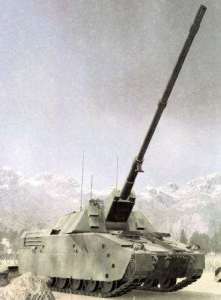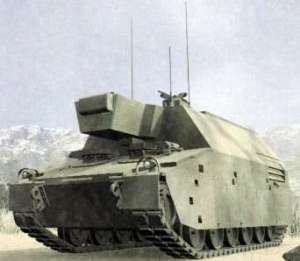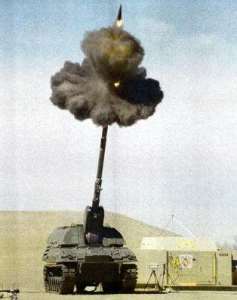| Designation: | CRUSADER SPH XM2001 |
 |
|---|---|---|
| Manufacturer: | BAE Systems Land and Armament | |
| Product type: | Armoured Vehicles | |
| Name: | Self-propelled howitzer |
The Crusader advanced field artillery system consists of the 155 mm self-propelled howitzer XM2001 and the companion resupply vehicle XM2002.
Crusader is expected to the US Army's current M109-series 155 mm self-propelled howitzer, whose basic design is over 40 years old, and the M992/M992A2 Field Artillery Ammunition Support Vehicle (FAASV).
The Crusader programme definition and risk reduction (formerly demonstration/validation) contract started in December 1994. The US Army's total contract value for this phase of the development is US$1 billion.
The originally covered performance period until April 2003 and calls for the design, development, testing, and delivery of two prototype Crusader self-propelled howitzers and one prototype Crusader resupply vehicle.
Crusader prime contractor and systems integrator is United Defense LP with Team Crusader members General Dynamics Land Systems responsible for mobility subsystem integration and Honeywell responsible for software development.
Key Team Crusader subcontractors include Alliant Techsystems, Applied Dynamics, Architecture Technologies, Ascent Logic, The Boeing Corporation, Digital Pilot Corporation, Kollmorgen, Lynx, MPC Products, Rational Software, Raytheon Systems, Saunders, Simplex Technologies, Technovative Applications, Upper Mohawk and Vector Research Incorporated.
In June 1999, United Defense LP announced that it would carry out final assembly and test of the Crusader system in a new facility to be established in Eglin, Oklahoma, adjacent to the Fort Sill artillery firing ranges.
At Eglin, United Defense LP intends to use subassemblies and major components provided by other manufacturing locations, including current United Defense and General Dynamics Land Systems manufacturing facilities.
It was expected that the first production XM2001 and XM2002 systems would be completed early in 2004, but as indicated later in this entry this has now slipped for a variety of reasons, including problems with software development.
Funding has been cut to help fund the US Army's new medium force. In February 2000 it was stated that a major redesign effort was underway to reduce the vehicles transport weight to 38 from 42 tonnes. To accomplish this goal the system will be reduced in size, carry modular armour and carry two smaller 25 round magazines instead of twin 30 round magazines as originally envisioned.
Crusader is being developed as a totally automated system for transfer, inventory, selection and loading of ammunition, fuze setting, fire control and secondary armament.
The fully automated features of the howitzer and resupply vehicles require only three crew members each for operation and maintenance. Automated ammunition handling enables crews to remain effective at extremely high operational tempos for extended periods of time.
Crusader will be equipped with integrated command and control providing onboard tactical and technical fire control as well as embedded training and decision aids. Co-located crews in each vehicle will operate with full situational awareness, and will be fully linked with the combined arms force.
The Crusader self-propelled howitzer will carry 50 155 mm rounds on board (in two magazines each holding 25 155 mm projectiles, two identical propellant charge increment magazines and two identical increment magazines), have a maximum rate of fire of 10/12 min, with a minimum range of 5 km and a maximum range of 40+ km and will be able to fire within 25 seconds of coming to a halt. The howitzer will have the capability to fire multiple rounds to achieve simultaneous impact on target.
The Crusader resupply vehicle will carry 100 155 mm rounds on board and will rearm the self-propelled howitzer at a rate of 50 rounds in 12 minutes as well as resupplying the vehicle with fuel.
Automated rearmament of the Crusader self-propelled howitzer will be accomplished with all systems and crew under armour to ensure continual high availability for missions, reduced resupply time, and improved crew survivability. Automated rearmament will include projectiles, charges, fuel, lubricant and water.
The Crusader main armament will use a 155 mm solid propellant cannon system. The armament system consists of an XM297E2 cannon, a laser ignition system, and a new XM200 gun mount based on the existing XM183E1. The cannon tube is Integral Midwall Cooled (IMC) and employs external cooling jackets to reduce thermal signatures and maintain tube temperatures in a range that is safe for sustained firing.
The multilug, slide-block breech assembly provides fast, automated actuation to support high rates of fire with the laser ignition system being integrated for compatibility with breech automation to support crew safety when firing at high rates for long durations.
The XM200 gun mount utilises a Schneider-type recoil mechanism consisting of two modular recoil cylinders with built in internal replenisher, recoil buffer and two modular recuperator cylinders.
The actual cannon tube is chrome plated to minimise wear and erosion and an integral pepper pot muzzle brake is incorporated as standard.
The Crusader armament system chamber volume, shape, and details are tailored for compatibility with the Modular Artillery Charge System (MACS) solid propellant propulsion system.
The MACS has been jointly developed by the US Army and an industrial team comprising ARMTEC, General Dynamics Ordnance and Tactical Systems and Alliant Techsystems. MACS is a modular, increment-based propelling charge system consisting of the XM231 and XM232 configurations. MACS charges are compatible with Crusader and all existing 155 mm cannon designs. MACS eliminates the need to dispose of unused propelling charges, and enables automated ammunition handling due to its sturdy case composition.
Crusader will take advantage of the pending fielding of the Multi-Option Fuze for Artillery (MOFA). The fuze is compatible with all 105 and 155 mm cannon artillery systems. It integrates four function settings for bursting projectiles: proximity, time, point detonating and delay. MOFA has manual and inductive (man-out-of-the-loop) setting compatibility for high rates of fire. MOFA also supports pre-fuzing of projectiles, allowing the Crusader system to inductively set and verify time settings before ramming projectiles.
Both Crusader vehicles will be capable of 48 km/h cross-country speed and 67 km/h highway speed. To avoid hostile counterfire, Crusader vehicles will be able to move 750 m in less than 90 seconds under combat conditions.
Crusader's advanced mobility suite will also include external hydropneumatic suspension from Textron Marine & Land Systems, and advanced track and drive by wire controls.
System survivability will be enhanced by mobility and additional features such as designed-in signature management, integrated defence systems and a macron NBC system. It will also have position navigation/movement planning decision aids and embedded diagnostics/prognostics.
Crusader low-rate production may begin in 2006 and full-rate production is scheduled for 2008. The first fielded unit is expected to be equipped in the year 2007.
For the extensive trials programme two XM2001 and one XM2002 systems were completed in 2001 but, in the Summer, the ammunition supply vehicle Minus was completed. This will not have the ammunition resupply system installed but will be used for reliability trials of the powerpack and the hydropneumatic suspension system.
Providing that there are no additional problems, the US Army is scheduled to make a Milestone II decision in April 2003 to enable it to enter the Engineering Manufacturing and Development (EMD) phase.
During this phase it is expected that seven Crusader self-propelled artillery systems, five tracked resupply vehicles and four wheeled resupply vehicles will be completed. The latter will be based on an Oshkosh M1075 (10õ10) truck chassis which is already used in large numbers by the US Army.
Currently the original and much heavier Crusader platforms are being used to maintain the development programme.
In October 2000, it was revealed that the Crusader had recently fired three-round bursts at a rate of fire of six rounds per minute. These tests were carried out with the weapon being aimed and fired by remote control with the automatic loader first loading the projectile and the charge system.
The original intention of the US Army was to procure as many as 1,138 systems but this has now been cut back to 480 systems that will be issued to 13 active and six National Guard battalions.
In addition to software problems, a major redesign of the Crusader and its associated tracked resupply vehicle has been carried out to reduce weight and enable a C-5B aircraft to carry two systems.
By reducing the length and width of the vehicle, reducing the ammunition load (projectiles and charges), designing a modular armour kit and changing the power pack, it is estimated that the weight of the system has been reduced from 60 tons (US) to between 48 to 50 tons (US) complete with fuel, ammunition and armour. Its air portable weight is expected to be around 40 tonnes, for example without ammunition, most of the fuel and applique armour package.
Crusader was originally expected to be powered by a British Perkins Engines Company CV-12 diesel but late in 2000 it was decided to use the new Abrams/Crusader Common Engine (ACCE) which will consist of a Honeywell/General Electric LV100-5 turbine coupled to an Allison automatic transmission.
The hydropneumatic suspension either side consists of six dual rubber-tyred roadwheels with the idler at the front and the drive sprocket at the rear and track-return rollers.
The 155 mm liquid-cooled ordnance, and firing characteristics such as range and rate of fire are not affected by the weight reduction programme and it still has a crew of three who will load, aim and fire the 155 mm ordnance by remote control.
Crusader will have a 155 mm/56 calibre ordnance (including the muzzle brake) and during recent trials 15 rounds (projectile and charge) were fired in 1 minute 43 seconds. For comparison, the current 155 mm M109A6 Paladin took 9 minutes 52 seconds to fire the same number of rounds.
In March 1998, the US Army approved the design of the Crusader and granted Team Crusader authority to commence the detailed design and fabrication of the four Program Definition/Risk Reduction (PD/RR) phase prototypes.
Each Crusader battalion will have three batteries each with six XM2001 155 mm self-propelled howitzers. It was originally intended that each XM2001 would be supported by a dedicated XM2002 but it is possible that these may well be pooled and deployed to the XM2001s as required.
According to United Defense, The Crusader increases overall force effectiveness by more than 50 per cent and force survivability by 30 per cent or more.
Two Crusader systems provide the same firepower as a six gun battery of Paladins, yet ownership costs are reduced by 5 per cent. Crusader uses 32 per cent less ammunition per target and requires 38 per cent less support than the current system.
Maximum road speed will be 67 km/h with cross country speed being 39 km/h. It has a dash speed of 750 m in 90 seconds.
Late in 2001 it was stated that the US Army was looking at ways to accelerate developing and fielding the Crusader system which is fully funded in the Fiscal Year 2002 budget.
Prior to the anticipated cutback in Crusader procurement and the anticipated restructuring of the whole programme, it was stated that a number of improvements were already under consideration to enable the system to become the M2001A1/M2002A1.
These included a new advanced power pack, active armour protection, possible electrothermal chemical cannon, use of more advanced materials in the hull and turret, enhanced command and control, communications and intelligence and other improved survivability measures.
A notional M2001A2/M2002A2 upgrade package could have included a new crew cockpit, real-time cannon operating system, new composite armour, simulation-based acquisition processes, real-time electronics, robotics, hit/detection avoidance, prognostics/diagnostics and a new suspension system.
|
||||||||||||||||||||||||||||||||||||||||||||
|
||||||||||||||||||||||||
Related Articles |
|
$245.3 Million U.S. Army Contract to Continue M109A7 Production (04.11.2015) |
|
United Defense Fires 1,000th Round from Non-Line-of-Sight Cannon Demonstrator (21.04.2005) |
 |
 |
 |
 |